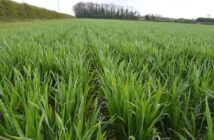The performance of Belepi, the Blackman Agriculture-bred wheat suitable for drilling from October through to the end of March, has impressed across both autumn and spring sowing slots on a Lincolnshire Wolds farm where seed production is a speciality.
The Fenwick family which owns and runs Beelsby Farming Company’s 800ha of light wold chalk to medium-heavy loam has been growing seed crops for over thirty years, and currently produces winter oilseed rape, spring beans and winter wheat using a variety of different establishment systems.
Discussions with Matthew Phillips of GFP Agriculture, for whom Beelsby Farming Company does a large part of its seed growing, led to an agreement that Belepi would one of the wheats which would be grown for GFP for 2015. With the benefits that it promises commercial growers – a drilling window spanning October to the end of March and a prostrate early growth habit that sees tillers spreading and so limiting light and space availability for competing weeds – Mr Fenwick was keen to see how the variety would perform in both autumn and spring drilling slots.
“We grew a total of 46ha (114ac) of Belepi for harvest 2015, of which 30ha (75ac) was for GFP, and we took full advantage of its drilling flexibility to sow at either end of its window, with some planted in the second week of October and some in early March,” he explains.
“Having that flexibility is a great reassurance that if the weather in October and November turns bad, there’s no need to panic, and any seed that hasn’t been drilled will still perform well if sown in the spring.
“Whether drilled at the early or late point in the sowing window, at seed rates which targeted 200 plants/sq m both crops of Belepi produced big canopies that appeared to cut the amount of light that could get through to any germinating grassweeds underneath, and this did seem to aid overall control.”
Just ahead of harvest, the variety’s ear size was particularly notable, says Mr Fenwick, and ultimately that translated into some healthy yields.
“The four winter-sown fields of Belepi we grew produced an average 10t/ha and a good specific weight, while the four spring-sown fields averaged 7t/ha at a slightly lower bushel score. Both looked very impressive over the season, producing a good early cover and going on to grow away strongly.
“Despite dull harvest weather, earliness of ripening was good, with the autumn-sown crops cut during mid to late August, and the spring-drilled in early to mid-September.
“Belepi appears to be a low-growing crop that produces some especially big ears. It’s a variety that provides us with the flexibility to drill over a six-month period and, if drilled in the spring, then brings with it the lower growing costs of a spring crop. If commercial growers look to the variety for the same reasons, then we could be growing it for some time to come.”



